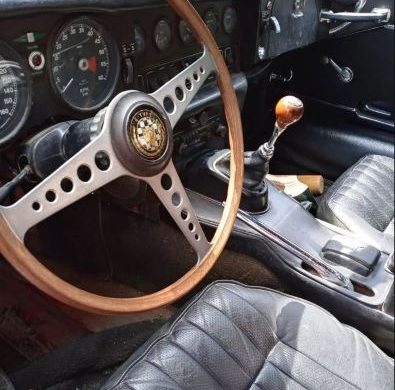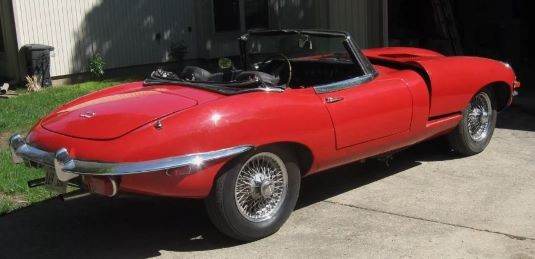Driver-Quality 1970 Jaguar XKE Series II Roadster
Which is your favorite Jaguar XKE? Do you prefer the early six-cylinder – triple-carburetted, toggle-switched, slippery of shape? Or the mid-range Series II, enhanced for driveability but compromised by design changes that catered to regulators? Or the last iteration – longer, heavier, and powered by an exotic aluminum-block twelve-cylinder? Here in Champaign, Illinois is the middle-of-the-road choice – many collectors’ favorite – a 1970 Jaguar XKE Series II. Though open headlights, larger signal lamps, and rounded knockoffs had become the norm, this car still sports small, chrome bumpers and the sinuous shape that made it famous. The seller has owned this car since the mid-1980s; it’s not flawless, but there’s something viscerally appealing about driving one of the world’s most beautiful cars without worrying about its cosmetics.
We asked for an engine bay photo but received no answer by the time of publication – too bad because the 4.2-liter six-cylinder is still gorgeous despite losing its triple SU carbs back in ’68 in favor of dual Strombergs. A four-speed manual helps hustle the Jag to sixty mph in less than eight seconds, and top speed is at least 130 mph. The seller reports that compression measures 150 lbs on all 6 cylinders. The car received a new water pump, a complete brake rebuild, and a new radiator within the last two years. An oil leak is evident at the front crank seal. It’s been tuned and is said to run, drive, and stop well. The odometer reads 64,567 miles. A Heritage Trust certificate will convey with the car; according to the seller, all numbers match. Yes, I see the unevenness in the curvature of the nose – a personal inspection is warranted.
The interior is slightly worn, but not shabby. A tolerant new owner probably wouldn’t do much more than condition the upholstery. Rather than the bum-numbing seats of the Series I, these later cars aimed for comfort, with plusher, supportive, but still attractive buckets. Note the rocker switches. The seller reports that there’s a small tear in the convertible top. The clock and the radio do not work.
The bonnet is clearly open in this photo – I’d want to know how well it fits. The trunk lid may be partially open or the panel may not seat properly – hard to tell. The Heritage Trust certificate records that the car was delivered wearing Primrose Yellow paint, and the seller admits that the yellow color is showing through in the engine bay and on the door jambs. The tool kit, spare, owner’s and shop manuals are with the car. If a Jaguar XKE is on your bucket list, this roadster is advertised here on eBay. Bidding has reached $35,100 and the reserve is not met. Series II cars can sell in the six-figure range; project cars will bring $25k or so. Without a personal inspection and more photos, assigning a value to this cat is difficult; what do you think?
Auctions Ending Soon
 2006 Ford Mustang Saleen S281 SCBid Now15 hours$15,000
2006 Ford Mustang Saleen S281 SCBid Now15 hours$15,000
 2002 Subaru Impreza WRXBid Now3 days$333
2002 Subaru Impreza WRXBid Now3 days$333
 1975 Chevrolet Corvette ConvertibleBid Now3 days$3,000
1975 Chevrolet Corvette ConvertibleBid Now3 days$3,000
 1964 Ford F-100 Camper CustomBid Now3 days$2,000
1964 Ford F-100 Camper CustomBid Now3 days$2,000
 2006 Jeep Wrangler SportBid Now5 days$10,500
2006 Jeep Wrangler SportBid Now5 days$10,500





Comments
Looks like a nice driver…..drive it and leave it alone!! (other than British maintenance)! : > }
Regarding the seats, Ser I 4.2 cars had buckets identical to these (except for the lack of headrests). It was only the earlier 3.8 cars that had those horrible bum busters.
Resale Red is a red flag for me. With no underbody, under bonnet, or rear suspension photos, only an on-site inspection will determine the condition and price.
Great history, art and kick-ass driving. I bought a 1961 Coupe in 73, sold it when I left my Navy squadron, bought a 69 Convertible in 80, and NEVER should have sold that but family came first, and finished out with a 74 Coupe in 1987, With the exception of the V12, these were easy to wrench, the hardest part was the inboard brakes. This and 911’s are my favorite, completely different but what a ride should be. Resale Red is right, get an inspection by a good body shop, the mechanicals are a hell of a lot cheaper to buy. Love to drive it though. There are a ton of jerks who now own these, sorta like everything else! Find a good driver, and if you can moderately wrench, you will have a great big smile driving down the road.
There is no such thing as an “XKE”, it is an E – Type!!!
The “Buff Books gave it that moniker, not Jaguar.
Actually, Jaguar referred to them as XK-Es in the States. Look up old brochures on eBay if you don’t believe me.
Read the bootlid lettering it states E – Type, period.
Look at one sometime.
I agree, XK-E was the nomenclature for USA.
If I had the time and inclination I would go down to my shed and dig out a reference, but time is a scarce commodity! Probably in one of my Daily Express “Report of the Earl’s Court Motor Shows”
Jaguar in Brown’s Lane, Coventry, NEVER referred to E Types as “XKEs”. It was American dealers who gave the car that unofficial designation. Some American Jaguar ads in the ’60s emanating from Jaguar America in Leona New Jersey, did say “XKE”…but it was a reflection of the fact that the totally unofficial “XKE” designation had caught on “in the colonies”. The final verdict here is that while Jaguar in England never called its sports car “XKE”, in America that designation became the car’s unofficial, but most common name in the ’60s-to-mid-70s. Nowadays it is in decline when it comes to usage, as new generations who did not exist back then look at what is written on the car (except the 3.8s that don’t say “E Type”).
All three series of E Types have their pros and cons. I owned a ’64 many moons ago. I loved the looks but the barely adequate brakes, cooling with that original single blade electric fan, and the Moss gearbox, made it somewhat of an exercise in masochism that I was willing to put up with when I was 18-19. Now that my age begins with a 6, I would not.
For the last seven years I have owned a Canadian spec ’69 roadster that is truly rust-free and bereft of any problems, because I maintain it dogmatically according to the owner’s manual and the factory manual. The triple calliper brakes with decently big braking surfaces, the comfortable seats, the greatly improved cooling, the smooth all-synchromesh gearbox, etc, make this series the one I give a big thumbs-up to. I have a small preference for the frontal appearance of the Series I, but on balance I consider the Series II the ultimate driver. Even the unfairly-maligned Zenish-Stromberg carbs are quite good when competently tuned, and give better mileage and lower emissions than the Series I, because they are thermostatic, atomize the fuel more finely, and the Series II distributor zaps that more finely atomized fuel way more aggressively than its Series I counterpart, leading to greater efficiency, which includes way less back-pressure in the exhaust system. This means a power gain to the rear wheels. The American Series II cars lost some power due to cross-over pipes, and beyond mid 1970, American export cars got lower compression, double the cross-over pipe hot smoke, very wide valve gaps, ash cannisters…agh…
This re-sale red E Type seems to be somewhere in the middle when it comes to condition, so unless someone has money to burn, an in-person inspection is a must. It is also going to need chrome frames for the tail lamps–something the Series III did not have because the whole rear was made larger…but the Series II did have them…to transition the lights elegantly to the still-original design profile.
Errata: I should have put above “ZeniTh-Stromberg”!
Ended at $38,600.
Reserve Not Met.